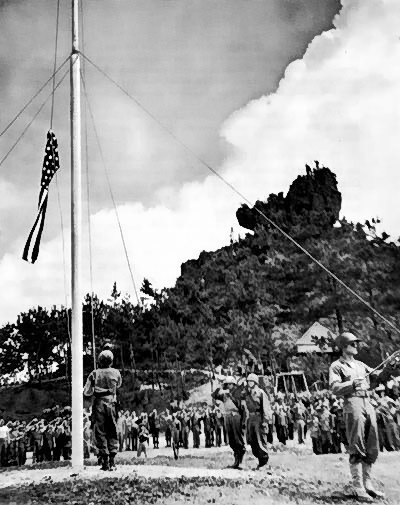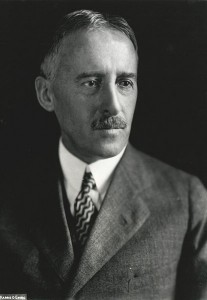Sarah Sundin's Blog, page 338
June 27, 2015
Today in World War II History—June 27, 1940 & 1945

US Sixth Army at Oriung Pass on Luzon, 14 June 1945, on way to Cagayan Valley.
75 Years Ago—June 27, 1940: President Roosevelt declares national emergency and invokes Espionage Act of 1917 to control shipping in territorial waters and Panama Canal and to take measures against sabotage. Roosevelt forms National Defense Research Committee under Dr. Vannevar Bush to coordinate civilian and military scientific and medical research.
70 Years Ago—June 27, 1945: US Sixth Army secures Cagayan Valley on Luzon and drives to Aparri on the north shore.
June 26, 2015
Today in World War II History—June 26, 1940 & 1945

Wu Yifang signing the United Nations Charter, Herbst Theatre, San Francisco, California, 26 Jun 1945. (Republic of China Ministry of the National Defense)
75 Years Ago—June 26, 1940: French General Charles DeGaulle forms French Volunteer Legion in London. USSR orders 56-hr work week, imprisonment for quitting jobs, fines for tardiness. Britain reduces meat ration due to shipping losses from U-boats.
70 Years Ago—June 26, 1945: The United Nations Charter is signed by 50 nations in San Francisco.
June 25, 2015
Today in World War II History—June 25, 1940 & 1945

Map detailing the German and Italian advances in France, 13-25 Jun 1940 (US Military Academy)
75 Years Ago—June 25, 1940: French-German armistice effective 0030. Cease fire effective in Italo-French conflict. Isolationist advertising appears in New York Times, secretly funded by Germany.
70 Years Ago—June 25, 1945: Austria divided into four Allied occupation zones. British Second Army (northern Europe) is stood down.
June 24, 2015
Today in World War II History—June 24, 1940 & 1945

US Secretary of the Navy Frank Knox, Navy Department, Washington, D.C., circa 1943. (US Navy photo)
75 Years Ago—June 24, 1940: British government sends gold bullion and securities to Canada for safekeeping. Charles Edison (son of Thomas) resigns as Secretary of the Navy to run for governor of New Jersey; Roosevelt appoints Republican interventionist Frank Knox, publisher of the Chicago Daily News, to replace Edison.
70 Years Ago—June 24, 1945: In a bombing raid, British destroy the infamous bridge over the River Kwai in Thailand, built at great cost by slaves and prisoners of the Japanese.
June 23, 2015
Today in World War II History—June 23, 1940 & 1945

Albert Speer, Adolf Hitler, and sculptor Arno Breker in Paris, France, 23 Jun 1940. (US National Archives)
75 Years Ago—June 23, 1940: Hitler tours occupied Paris. Pope Pius XII publishes encyclical Saeculo Exeunte, honoring Portugal on its 800th birthday.
70 Years Ago—June 23, 1945: In last airborne assault of the war, paratroopers of the US 11th Airborne land near Aparri in northern Luzon.
June 22, 2015
Lessons from the 1940s Woman – Women’s Work Is Good Work
The World War II era was a pivotal time for women, a hinge between the traditional home-based women’s role and the modern career-based role. Wartime posters show the fullness of a woman’s place in society and reveal the values that drove this generation to victory. Through these posters we’ll see lessons we can learn from women of that era.
She’s canning. In a frilly apron. And she’s smiling.
To many modern woman, this image looks hokey. Doesn’t she know that kind of work is drudgery? A waste of her potential? Beneath her?
While the women’s movement opened up traditional men’s work to women, somehow in the process, traditional women’s work was demeaned. Child care, cleaning, laundry, and routine cooking are seen by many women as drudge work. When I gave up a promising full-time career in pharmacy to stay home with my children, I was told I was wasting my education and intellect, and I’d be bored out of my skull.
In the 1940s, women saw all work as good work. They knew raising children was an honor and privilege. They knew their labor in the home benefitted the family and society. Because they saw the inherent value of their work, most women found it fulfilling. For further fulfillment, women volunteered with civic and church organizations, or engaged in arts and hobbies.
Women can now work outside the home in traditional men’s jobs. That is a good thing. Single women don’t need to marry in order to eat, and married couples have options, especially welcome in a tough economy.
But why must we demean housework to gain that option? Why is traditional women’s work of less value than traditional men’s work? Isn’t that attitude, in its essence….sexist?
Perhaps it’s time to recognize that all work has an element of drudgery to it, whether it’s scrubbing toilets or passing paperwork from the inbox to the outbox. Perhaps it’s time to recognize that all work has value and benefits the family and society as a whole. If we cling to this, maybe we can find joy and fulfillment in our labor, whether paid or not.
I’m thankful that many young women nowadays are rediscovering the “domestic arts,” and are embracing the same duties the previous generation rejected.
I’m off to fold laundry. With a smile. I might even put on an apron.
Today in World War II History—June 22, 1940 & 1945

Wilhelm Keitel accepting the French surrender from Charles Huntzinger, Compiègne, France, 22 Jun 1940. (German Federal Archive: Bild 146-1982-089-18)
75 Years Ago—June 22, 1940: France signs armistice with Germany at Compiègne, splitting into a Nazi-occupied zone in the north and a Vichy French zone in the south. In Japan, Prince Konoye Fumimora forms a new cabinet with Hideki Tojo as Minister of War.
70 Years Ago—June 22, 1945: Battle for Okinawa officially ends at a high cost—13,000 Americans killed, 108,000 Japanese killed, including thousands of civilians who committed suicide. The US Navy took its heaviest losses of war with 36 vessels sunk. In addition, the US lost 763 planes and the Japanese lost 8000.

Raising the US flag on Okinawa, Japan, 22 Jun 1945. (US Army photo)
June 21, 2015
Today in World War II History—June 21, 1940 & 1945

US Marines and US Army soldiers celebrating the capture of Hill 89, Okinawa, Japan, 27 Jun 1945; the hill was captured by US Army 7th Inf Div on 21 Jun 1945. (US Marine Corps photo)
75 Years Ago—June 21, 1940: Polish government-in-exile arrives in London. Lawyer and future president Richard Nixon marries teacher Pat Ryan in Whittier CA.
70 Years Ago—June 21, 1945: US Rangers link with Filipino guerillas in Aparri, Luzon in the Philippines. US Tenth Army takes Hill 89 on Okinawa, last Japanese stronghold.
June 20, 2015
Today in World War II History—June 20, 1940 & 1945

Henry Stimson, 1929 (Library of Congress)
75 Years Ago—June 20, 1940: President Roosevelt names Republican interventionist Henry Stimson as Secretary of War. Germany begins conscription of Dutch civilians for forced labor.
70 Years Ago—June 20, 1945: Australians take oil fields at Seria on Borneo.
June 19, 2015
Today in World War II History—June 19, 1940 & 1945

French refugees on a road near Gien, France, 19 Jun 1940. (German Federal Archive: Bild 146-1971-083-01)
75 Years Ago—June 19, 1940: Germans continue their conquest of France, taking Cherbourg, Brest, Nantes, Saumur, Tours, and Strasbourg. Comic strip premiere of “Brenda Starr, Reporter,” the first written by a woman.
70 Years Ago—June 19, 1945: US Gen. Dwight D. Eisenhower receives a ticker-tape parade in New York City.




